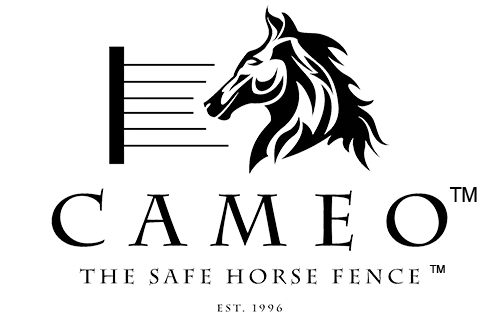Is a “Stronger” Fence Always a Safer Fence for Horses?
We've all heard the saying: "the stronger the fence, the safer the horse." But is that really true?
When it comes to equine safety, strength alone can be misleading. A horse at full gallop crashing into a rigid steel or wood fence doesn't encounter safety—they face potential injury. In reality, the most safe horse fence is one that balances strength with flexibility, visibility, and impact reduction.
In this article, we’ll break down the myths surrounding horse fencing safety, reveal the truth behind traditional assumptions, and introduce you to a solution trusted by veterinarians, equine experts, and horse owners alike: Cameo™ Horse Fence.
Myth #1: “Stronger = Safer”
The Myth:
Heavier materials like steel and wood are safer because they’re harder to break.
The Reality:
Rigid materials are unforgiving. Horses can spook, bolt, or crash into fencing, and when they do, inflexible barriers don't protect—they harm. Horses tangled in barbed wire or splintered by broken wood rails often require costly vet care and prolonged recovery.
The Cameo™ Fix:
Cameo™ Horse Fence is a metal-free, polymer-based monofilament that flexes on impact and returns to shape. It minimizes injury risk and maintains structural integrity without sacrificing containment.
Myth #2: "Electric Fencing Works Fine On Its Own"
The Myth:
One strand of electric wire is enough to keep horses in.
The Reality:
Electric fences require consistent power, visibility, and maintenance. When power fails (storm, outage, faulty charger), the fence fails too. Even when powered, a single strand offers little physical deterrent if a horse runs through it.
The Cameo™ Fix:
Cameo™ fencing offers high-visibility polymer lines that provide containment even without electricity. Add solar-powered electric chargers for additional deterrent without reliance on the grid.
Myth #3: “Wood Is the Gold Standard”
The Myth:
Wood fences are the traditional and superior choice.
The Reality:
Wood looks beautiful, but it comes with drawbacks:
-
Rots and warps
-
Splinters dangerously
-
Requires frequent painting or replacement
-
Can break under pressure or impact

The Cameo™ Fix:
Cameo™ polymer fencing is rot-proof, splinter-free, and virtually maintenance-free. It offers clean lines and modern appeal without compromising safety or durability.
What Makes a Fence Truly Safe for Horses?
Essential Qualities of a Safe Horse Fence:
-
Visibility: Horses need to see the fence to respect it.
-
Flexibility: The fence must absorb and rebound from impact.
-
Non-toxic Materials: No rust, paint chips, or sharp splinters.
-
No Metal: Metal fences can cut or entangle a panicked horse.
-
Minimal Maintenance: A safe fence is a dependable fence.
Cameo™ Horse Fence checks every box.
Real-Life Test: Fencing for a Hero
In Iowa, a veteran's daughter reached out for help. Her father needed a safe space for his horses, and the community delivered. Taylor Fencing, in partnership with Cameo™ Horse Fence System, the American Fence Association, and local pros installed over 1,000 feet of fencing in just 8 hours.
This real-world example shows how Cameo™’s system:
-
Protected horses during high stress
-
Installed rapidly
-
Withstood heavy weather
-
Required minimal follow-up maintenance
Watch the full story here: Fencing for a Hero – Cameo x Taylor Fencing
Common Horse Fence Injuries (And How to Avoid Them)
| Fence Type | Common Injuries |
|---|---|
| Wood | Splinters, broken bones, impalement |
| Barbed Wire | Deep lacerations, scarring |
| Steel Pipe | Fractures, blunt trauma |
| Smooth Wire | Entanglement, tendon damage |
| Cameo™ | Minimal risk, low-impact flexibility |
Veterinary bills from fencing injuries can easily exceed $3,000. Choosing a safe horse fence like Cameo™ could mean the difference between a quick spook and a life-threatening accident.
Horse Owner Checklist: Is Your Fence Safe?
If you answered “No” to any of the above, it might be time to upgrade.
FAQ: Safe Horse Fencing Questions Answered
Q: Can Cameo™ fencing be used with electric lines? Yes! It’s compatible with solar or AC-powered chargers for added deterrence.
Q: How many lines are recommended? 4 lines for average horses, 5 for jumpers or larger breeds. Miniature horses or ponies may be fine with 3.
Q: How long does Cameo™ fencing last? With UV protection and zero metal corrosion, it’s built to last decades.
Easy DIY Install, Lasting Safety
One of Cameo™’s greatest strengths? It’s easy to install with:
-
Wood or T-post compatibility
-
Corner post insulators
-
One-way anchor vises
-
Gripple fence joiners
No welding, no painting, no headaches.
Need help? Email your pasture layout to info@cameofencing.com or call 1-800-822-5426.
Internal Resources
External Resources
Final Word:
Safety doesn’t mean rigidity. It means foresight, compassion, and design. If you’re serious about your horse’s health, ditch the myths and choose a safe horse fence that puts their well-being first.
Choose wisely. Choose Cameo™.

